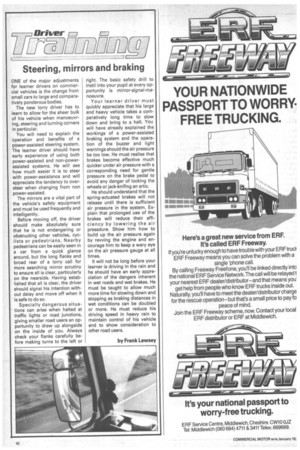Steering, mirrors and braking
Page 38

If you've noticed an error in this article please click here to report it so we can fix it.
ONE of the major adjustments for learner drivers on commercial vehicles is the change from small cars to large and comparatively ponderous bodies.
The new lorry driver has to learn to allow for the sheer bulk of his vehicle when manoeuvring, steering and turning corners in particular.
You will need to explain the operation and benefits of a power-assisted steering system. The learner driver should have early experience of using both power-assisted and non-powerassisted systems. He will see how much easier it is to steer with power-assistance and will appreciate the tendency to oversteer when changing from non power-assisted.
The mirrors are a vital part of the vehicle's safety equipment and must be used frequently and intelligently.
Before moving off, the driver should make absolutely sure that he is not endangering or obstructing other vehicles, cyclists or pedestrians. Nearby pedestrians can be easily seen in a car from a quick glance around, but the long flanks and broad rear of a lorry call for more searching mirror scrutiny to ensure all is clear, particularly on the nearside. Having established that all is clear, the driver should signal his intention without delay and move off when it • is safe to do so.
Specially dangerous situations can arise when halted at traffic lights or road junctions, giving smaller road users an opportunity to draw up alongside on the inside of you. Always check your flanks carefully before making turns to the left or
right. The basic safety drill to instil into your pupil at every opportunity is mirror-signal-manoeuvre.
Your learner driver must quickly appreciate that his large and heavy vehicle takes a comparatively long time to slow down and bring to a halt. You will have already explained the workings of a power-assisted braking system and the operation of the buzzer and light warnings should the air pressure be too low. He must realise that brakes become effective much quicker under air pressure with a corresponding need for gentle pressure on the brake pedal to avoid any danger of locking the wheels or jack-knifing an artic.
He should understand that the spring-actuated brakes will not release until there is sufficient air pressure in the system. Explain that prolonged use of the brakes will reduce their efficiency by lowering the air pressdure. Show him how to build up the air pressure again by revving the engine and encourage him to keep a wary eye on the air pressure gauge at all times.
It will not be long before your learner is driving in the rain and he should have an early appreciation of the dangers inherent in wet roads and wet brakes. He must be taught to allow much more time for slowing down and stopping as braking distances in wet conditions can be doubled or more. He must reduce his driving speed in heavy rain to maintain control of his vehicle and to show consideration to other road users.










































